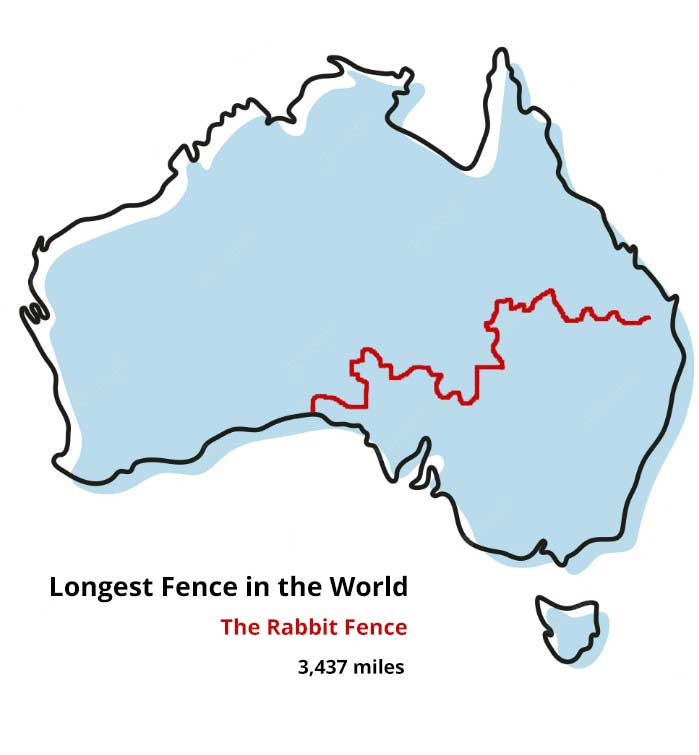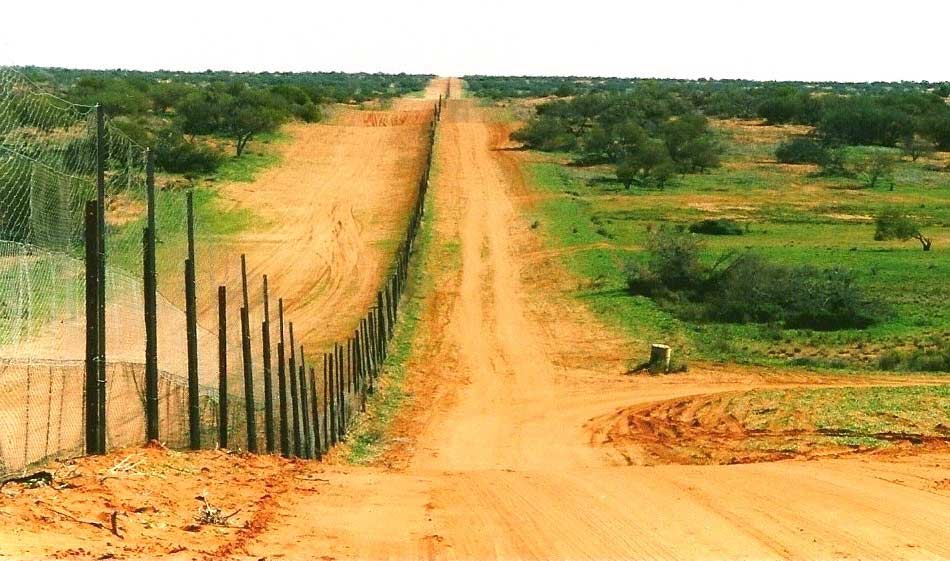Have you ever encountered an endless fence during a drive or while walking? For hundreds of years, large-scale agriculturalists and ranchers have utilized extensive fencing as a method to deter unwanted animals and safeguard their crops and livestock.
The longest fence in the world, also known as the dingo fence, is located in Australia and stretches for 3,437 miles (5,531 kilometers). The fence is 6ft high plus 1ft underground and was built to keep certain pests in Australia, mostly rabbits and wild dogs (dingoes), from the fertile lands.
The longest fence in the world is the longest border or barrier built by man and in this article, we’ll discuss the Who, why, and when questions concerning the longest fence in the world.

What we cover
ToggleWhat is The Official Name of the Longest Fence in the World?
The official name of the longest fence in the world is The State Barrier Fence of Western Australia. The name explains the fence as a barrier between the western and the southeastern side of Australia.
However, this popular spot is commonly known and referred to as the dingo fence but this has not always been so.
The fence is also known as the following titles;
- The Rabbit – Proof Fence
- The State Vermin Fence
- The Emu Fence
The longest fence in the world was named during these times for the animals and pests it was proposed to keep out.
The Geography of the Longest Fence in the World.
The longest fence in the world can be divided into sections with
- The Great Barrier Fence or Wild Dog Barrier Fence is located in Queensland and stretches over 1553 miles. This connects with the Queensland Border.
- The Queensland Border Fence stretches over 245 miles and connects with the South Australian Border Fence.
- The South Australian Border Fence runs along the border of New South Wales and stretches over 160 miles and this finally connects with the Dog Fence
- The Dog fence is located in South Australia and stretches over 1383 miles.

Who built the Longest Fence in the world?
The longest fence in the world stretches for 3437 miles and was an effort by the Australian government-backed heavily by the community of Australian farmers in the late 1800s.
The fence was built to keep out the pests that were killing their sheep, destroying their livelihoods, and just plain nuisance.
The sheer length of the fence depicts that it wasn’t an easy task especially as the fence is unbroken throughout its length. However various sections were built separately in the late 1800s and later joined in 1946 to 1950.
Why was the Longest Fence in the World Built?
The longest fence in the world might seem like a wonder or a visitor’s attraction while visiting Australia but the fence was built to serve a very necessary purpose at the time. Here are some of the reasons why the fence was built.
- To keep rabbits away.
Rabbits might be herbivores but a large number of rabbits meant that a lot of the grazing grassland was being devoted leaving inadequate amounts for the sheep. Building the border helped control the rabbit population.
- Protect farm animals from wild dogs (dingoes).
One of the major reasons for building the longest fence in the world was to stop the attack on farm animals by dingoes. Dingoes are wild dogs indigenous to Australia and are one of the largest predators in the country.
- To protect the sheep.
Australia is known for having more sheep than people and the majority of farmers rear these farm animals. Dingoes are one of the biggest predators of the local sheep and the Fence was constructed to protect the sheep.
- To reduce the number of pests on Australian farmers and their farmlands.
Farmers would lose thousands of sheep to dingoes and grasslands to rabbits every year before the fence was built and that number dropped significantly after the border was erected.
How Long did it Take to Build the Longest Fence in the world?
Building a regular fence might take a weekend or two. However, when you’re talking about a 3437-mile fence, the time range changes drastically.
Construction of the longest fence in the world began in 1859 and was completed in 1885. This means that it took twenty-six years (26 years) for the dingo fence to be constructed.
However, the fence was built in sections. It was connected to form the unbroken barrier called the dingo fence from 1946 to 1950.
What material was used to build the longest fence in the world?
Building an unbroken fence of over 3,000 miles requires durable and reliable materials. Although the fence was built a century ago and has had to undergo extensive maintenance, the original materials used to build the fence were of good quality and durable.
The major material used in the construction of the longest fence in the world is wire mesh but some areas along the South Australian Border Fence have multi-strand electric fences.
Was the Longest Fence in the world successful?
Concerning the original purpose of building the longest fence in the world, the fence has been successful. It includes keeping the rabbits and dingoes from crops and local animals like the sheep that Australians are known for rearing.
The fence was also very successful in early eliminating the population of dingoes within the barrier and reducing the damage that they do to local farmers when they have access to farmlands and farm animals.
Although as the dingo fence grows older, maintenance is necessary to ensure that dingoes don’t get into the farmlands through weak spots in the wire mesh fence.
What was the Cost of Building and Maintaining the Longest Fence in the World?
Building the longest fence in the world with a length of over 3437 miles is a feat. Although we don’t know the original cost of building the longest fence in the world, we can use today’s standard to figure out an approximate amount.
The longest fence is constructed mainly out of wire mesh and 1 meter of wire mesh costs an average of $9. So if The dingo fence is 5531 kilometers, the cost of building the dingo fence in this day and age will cost about $50,000,000 not including the cost of timber, labor, and miscellaneous.
Regardless of this figure, the Australian government spends about $10 million on maintenance and monitoring.
There is also an estimated $25 million bill to repair the weak parts of the fence that are vulnerable to tear and wear. This could give the dingos a way into pastures to prey on the livestock.
Are there any disadvantages of the longest fence in the world?
Building the longest fence in the world was to keep predators out of farmers’ lands and livestock and this has been achieved relatively well.
However, the removal of one of the major players in the Australian ecosystem might pose an issue for the land.
The dingo fence has managed to drastically reduce the population of dingoes within the fence. However, this absence of one of the top predators within the fence has led to the usual prey which includes kangaroos, etc. thriving.
Excess increase in the kangaroo population means more grass consumption and no control over the population explosion.












